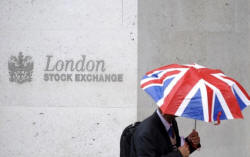|
Sterling slide fuels
risk-off on U.S. payrolls day
 Send a link to a friend
Send a link to a friend
 [October 07, 2016]
By Vikram Subhedar [October 07, 2016]
By Vikram Subhedar
LONDON
(Reuters) - Sterling recouped some losses after plunging almost 10
percent on Friday, as growing fears of a "hard" exit by Britain from the
European Union sent a shiver through world stocks markets before U.S.
jobs data.
The pound had slumped as much as 10 percent in Asia as it crashed
through key support levels, triggering a wave of selling. It recovered
in European trading but was still down 2.7 percent at $1.2271.
The impact of sterling's slide on other asset classes was relatively
muted, though caution prevailed. U.S. stock futures were down 0.3
percent before U.S. payrolls data, which could put pressure on the
Federal Reserve to raise interest rates.
European stocks fell 1 percent, dragged down by airlines and other
consumer-related sectors.
The STOXX 600 has fallen by around 7 percent since the start of 2016,
with investors pulling funds from European equities for 35 straight
weeks, the longest streak on record, according to Bank of America
Merrill Lynch.
The plunge in the pound, which is poised to fall about 5 percent for the
week, lifted London's FTSE as investors bought shares of dividend-paying
exporters such as oil majors and mining companies. The UK benchmark is
less than 1 percent from record highs.

The pound has come under renewed pressure as expectations grow that
Britain's divorce from the EU will be messier and costlier for the
economy than expected. British Prime Minister Theresa May on Sunday set
a March deadline for beginning the formal departure process from the EU.
"This move has shaken things in sterling and a huge amount of any
outstanding positioning will have been washed out and we may be starting
from a new, even more nervous footing," Citi trader Sam Underwood wrote
in a note to clients.
Sterling's slide spurred another round of bearish forecasts on the
currency.
HSBC said on Friday it forecast the pound would drop to $1.10 and parity
against the euro by the end of 2017. Morgan Stanley said it expected the
currency to retest the session's lows of $1.20 in coming weeks.
"The pound used to be a relatively simple currency that used to trade on
cyclical events and data, but now it has become a political and
structural currency. This is a recipe for weakness given its twin
(budget and current account) deficits," said David Bloom, global head of
FX research at HSBC.
POUND ROLL TO PAYROLLS
Focus for market participants in other assets shifts to the U.S. monthly
jobs report later in the day. If job creation is robust, it may cement
the case for a U.S. rate increase in December.
Economists polled by Reuters forecast U.S. non-farm payrolls to increase
by 175,000.
[to top of second column] |

A worker shelters from the rain as he passes the London Stock
Exchange in the City of London at lunchtime October 1, 2008.
REUTERS/Toby Melville/File Photo

A
disorderly reaction to possible U.S. interest rate hikes could disrupt capital
flows and heighten asset price volatility in Asia, the International Monetary
Fund said on Thursday.
Elsewhere in currency markets, the dollar edged down 0.1 percent against the yen
to 103.80 after hitting its highest level in a month on Thursday.
The euro eased 0.3 percent to $1.1120, poised to shed 1 percent for the week.
The dollar held firm after data on Thursday showed the number of Americans
filing for unemployment benefits unexpectedly fell last week to near a 43-year
low, boding well for Friday's data.
Interest rate futures are now pricing in about a 65 percent chance of a rate
hike by December, compared with less than 50 percent late last month.
The
10-year U.S. Treasuries yield rose to a three-week high of 1.746 percent on
Thursday before easing slightly to 1.73 percent on Friday.
Gold dropped to $1,252 per ounce, its lowest in three and a half months, after
declining 5 percent on the week. It last stood at $1,258.8.
Silver has slumped more than 10 percent so far this week to a four-month low of
$17.1525 per ounce.
Oil prices steadied after U.S. crude broke through $50 a barrel overnight,
spurred by an informal meeting among the world's biggest producers on output
cuts and falling U.S. crude inventories.

U.S. crude futures gave up earlier gains and were down 0.4 percent at $50.47,
just below Thursday's four-month high of $50.63. Brent fell 0.6 percent but is
close to its highest levels this year.
(Reporting by Vikram Subhedar and Marc Jones; Editing by Larry King)
[© 2016 Thomson Reuters. All rights
reserved.] Copyright 2016 Reuters. All rights reserved. This material may not be published,
broadcast, rewritten or redistributed. |